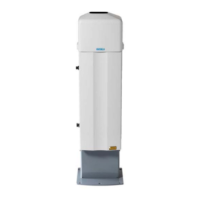USER'S GUIDE____________________________________________________________________
52 __________________________________________________________________ M210482EN-D
hits and the amount covered by high clouds are determined for the unit.
Total sky cover is adjusted using the value received from the
Initialize
module. The adjusted total sky cover gets the value of 8 only if no clear
sky was detected and the measurements do not have any features that
indicate there is no overcast condition.
The
Clusterize module combines hits into clusters. First the cloud hits
are combined into clusters, using an algorithm that looks for layers where
the horizontal difference between consecutive hits is small, and then by
algorithm that allows large height differences between consecutive hits.
These two algorithms are needed to make sure that in simple cases,
separate layers are not combined and in difficult cases the algorithm does
not report too many layers. After all hits have been combined into
clusters, a height is assigned for each cluster. First, the height below
which 10 % of all hits within the cluster are, is selected. Then, the height
of the cluster is calculated as an average of selected hits around this
height.
The
Combine module combines clusters into a single list of layers. The
module goes through all possible layer heights. A cover value is
calculated for each height. The calculated value is the sum of the cover
values of those clusters whose base height is between the height of the
layer and the height of the layer plus vertical extent of the layer. Vertical
extent of the layer is 100 feet or 10 % of the height of the layer, which
ever is bigger. The height that has the largest cover value is used in
forming a new layer. The height of the new layer is equal to a weighed
sum of those clusters that were within the vertical extent of the layer.
After the layer has been formed, the clusters are deleted and if there are
any uncombined clusters left, the process will be repeated.
The
Select module chooses the layers to be reported by the algorithm.
The first step is to assign high cloud cover to a single cloud layer. If the
highest layer is above the threshold height, high cloud cover is assigned
to that layer; otherwise a synthetic layer is created at 25 000 feet. The
second step is to determine which layer to report as the lowest one. After
the lowest layer has been determined, the
Select module rounds layer
heights into 100 feet precision. Layers closer than 100 feet to the layer
that is below them or whose sky cover is 1/16 or lower (less than 1/2
octas) are combined with the layers that are immediately below them.
The height of the combined layer is the height of the lower layer. If the
number of layers is still more than the number of layers requested, the
algorithm combines the layer which covers the least amount of sky to the
layer that is below it. This is done as many times as necessary to reduce
the number of layers to the requested number. The lowest layer is not
checked in either of the above two conditions.
The last phase of the
Select module is to calculate the cumulative cloud
cover for the reported layers. This value is simply the sum of the sky
cover of the layer and all the layers below it converted into integer octas.

